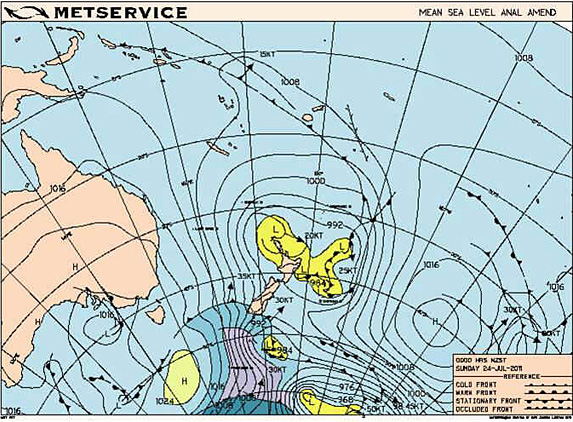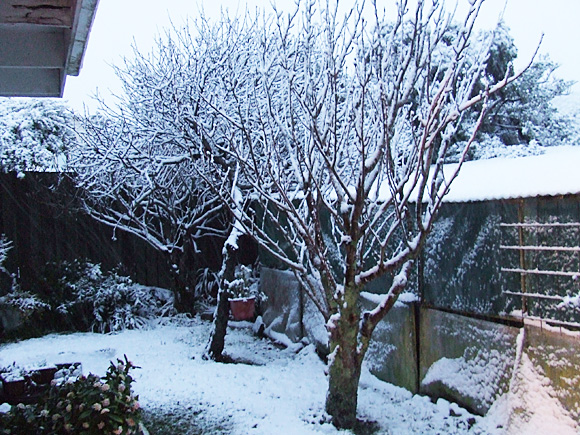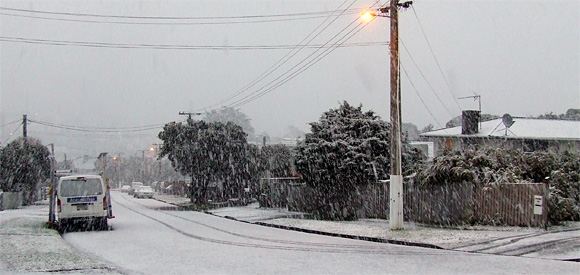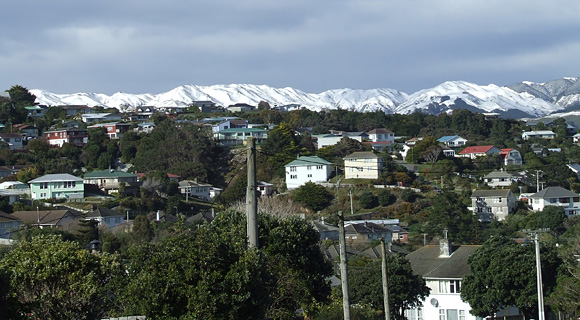|
Zeitblick
/ Das Online-Magazin der HillAc -
1. November 2011 - Nr. 41
|
|
City, My City |
|
Series 5, Part 1 A Significant Winter Event "The first fall of snow is not only an event, it is a magical event. On Sunday August 14th 2011 it wasn't a storm as such. In fact, as I remember it, the wind was quite gentle though distinctly from the south. In New Zealand's southern climes a wind from the south is synonymous with colder temperatures, and by golly it was cold on that day. Temperatures tumbled from their usual mid-winter 6's, 8's and 10's to 3's, 2's and, in many cases 0's and below. For us in the Wellington district the more the evening drew in the colder it got. It had already frozen over southern parts of New Zealand, dumping drifts of snow as it passed and then continued over us and to the north causing temperatures to plunge throughout the country. Our weather service had warned of a severe cold spell approaching from the south. In fact, in terms of what the weather forecasters were predicting, "the south" was the ice covered continent of Antarctica, a mere 5,000 km away from the southern shores of New Zealand. I have stated before in one of my stories that there is nothing between New Zealand and those great icebound wastes which can divert a cold southerly blast so it is not uncommon to hear our weather announcers use terms such as "the fridge door has been left open" to describe such cold winds. This jet stream of super-chilled air, more akin to snap freezing than refrigeration, travelled rapidly north squeezed between a low pressure weather system to the west and a high pressure system to the east. The wind-tunnel effect created by these circular weather patterns and fed by cold air from the Antarctic forced this chilled torrent northwards directly towards the long narrow land mass of New Zealand.
We had been reading in the daily newspapers and seeing on televised weather reports that, in the days before Sunday, the first falls of snow had "touched down" upon the south of New Zealand. Now while snow in winter is far from a new experience for many parts of New Zealand, the extent and coverage of the snow on Sunday 14th and Monday 15th of August 2011 was a first for many New Zealanders. Thankfully sufficient warning had been given to farmers to move their stock, particularly sheep, into sheltered paddocks and Spring lambs had yet to be born. There is nothing worse than seeing a pile of frozen baby lamb carcases, born warm from their mothers wombs and cut down by unseasonably bitter weather. Typically, as Wellingtonians, we assumed that the results of this particular weather pattern would not be as severe as the warnings we were hearing. Of course we thought that we'd heard it all before and that it would never be as bad as they predict. Plus we knew that frigid weather in New Zealand affects the country as far north as Christchurch and southwards, on the taller mountain rages in both islands and across the high plateau dominating the centre of the North Island. Snow in Wellington? Get out-a here!
At about 3:00pm on Sunday 14th, after having several sleet-like showers pass over, my sister-in-law phoned and said "Are you enjoying the snow?" to which I replied "What are you talking about?" It's cold, I thought, we've had showers, followed by sleet and even some hail, but snow? Of course we looked outside and saw, to our absolute amazement, the beginnings of snow fall. Over the next 2 or 3 hours the snow continued to fall. By now the ground was cold enough to stop the snow from melting and the layer of snow began to build. Soon every surface was covered by a layer of white and the wonder continued. Phone calls were made and received, we shared experiences with friends and family and learned what they were seeing, thinking and experiencing. We could hear children outside shouting with delight as they played in the snow and threw snowballs, perhaps for the first time in their lives, and enjoyed the supreme moment. Dusk fell and there was a knock on the door. There stood two of our grandchildren - Laura and Ryan - soaked through, flushed with cold and laughing their heads off. They had planned to knock on the door and throw a snowball at whoever opened it but decided it might be too much of a shock for their Grandparents. Bubbling with laughter and completely oblivious to the biting cold they stood for 5 minutes dripping puddles of melted snow on the kitchen floor. They then departed, laughing and happy, to walk the short distance home as the night drew in. Almost the whole of the television news report that evening dealt with the unexpected and wide-spread snowfall across the country. As the cold front travelled north it shed snow over towns and cities which, in the lifetime of many, had never experienced anything like it. Even Auckland, Northland and Cape Maria Van Diemen, at the very northern sub-tropical tip of New Zealand experienced dustings of snow, an event which had not occurred since 1939.
As I mentioned in the previous paragraph, such an event is not unheard-of in New Zealand. Almost exactly 72 years perviously, on August 1st, 2nd and 3rd, 1939 the country was again in the grip of a similar ice blast from Antarctica. National newspapers reported as follows:- Evening Post August 1st 1939 - "Without parallel in the memory of the oldest, settlers, or even in the mythology of their Maori predecessors, a fairly heavy fall of snow was experienced at Cape Maria Van Diemen this afternoon. The most northerly point in New Zealand, the Cape usually enjoys a subtropical winter climate, but for a few hours today there was presented the unique spectacle of a ridge covered for about a mile by an appreciable depth of snow. There was no general fall, and the flakes descended over a sharply-defined patch of ground. The fall lasted for about half an hour Though the snow was confined to one area, every centre in the far north reported unusually cold weather." Evening Post August 2nd 1939 - "Press Association messages indicate that snow was fairly general this morning in the lower part of the North Island. In Dannevirke it started between 4 and 5 o'clock and lasted about five hours, three inches falling throughout the district. Five to six inches of snow fell in Norsewood, Ormondville, Mako-i-tuku, and Tataramoa and from five inches elsewhere. Road transport is difficult, especially on a stretch three miles south of Norsewood, where many cars were held up. Wanganui and the surrounding district experienced heavy falls. In some districts it was a new experience, the snow being up to two inches deep. An unprecedented fall was experienced in Marton, the borough streets being covered to a depth of nearly two inches, with drifts a foot deep in places up to 9 o'clock, when a thaw set in. At Mount Curl and other high country in the Tutaenui district, five miles north of Marton, there were six inches of snow, this being a record. Heavy snow commenced to fall in Taihape at 7.30 am, and settled to a depth of four inches in the town by 10 am. Roads, both north and south, have been declared unsafe by motorists. Several cars skidded off the roads. There was no serious damage or injury, however. The short road from Taihape to Napier is also blocked. Rain and hail followed a frost at Hastings. There were heavy snowfalls in the back country. Fortunately, the main lambing will not begin for another week at least. On the higher country, sheep are likely to suffer in condition unless the weather abates. Lambing has commenced on many farms on the plains and lower hill country, but no heavy losses are yet reported, and in most instances it has been possible to provide shelter for ewes with lambs. Another spell of cold, wet weather early in August, however, would have disastrous results for many flocks." Evening Post August 3rd 1939 - "Motorists passing a property on the main highway between Takapau and Waipukurau have remarked with amusement on the appearance of a flock of lambs, which have all been fitted with neat black covers to protect them from the rigorous weather, states the "Daily Mail." The farmer's solicitude for the comfort of his flock is, however, not entirely due to humanitarian motives, but more to the fact that the sheep are stud animals and therefore are particularly valuable."
© Peter Wells, Wellington, New Zealand |
|



